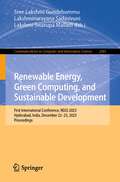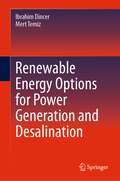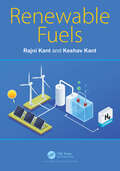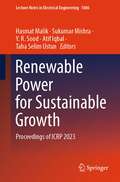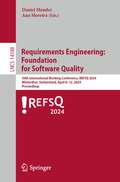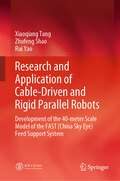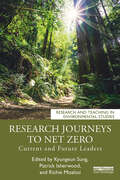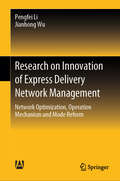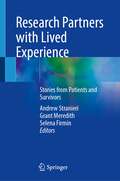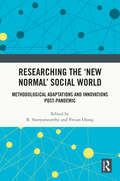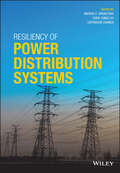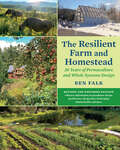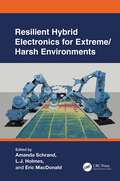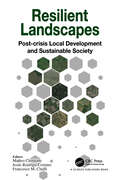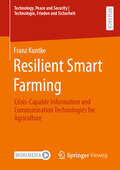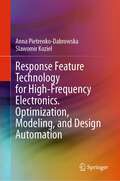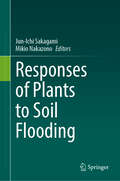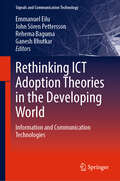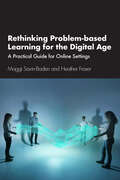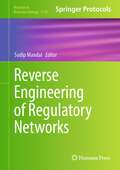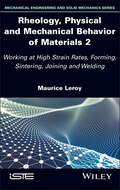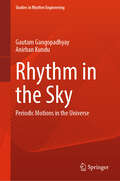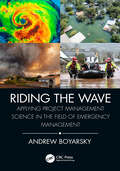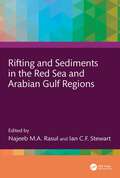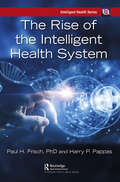- Table View
- List View
Renewable Energy, Green Computing, and Sustainable Development: First International Conference, REGS 2023, Hyderabad, India, December 22-23, 2023, Proceedings (Communications in Computer and Information Science #2081)
by Sree Lakshmi Gundebommu Lakshminarayana Sadasivuni Lakshmi Swarupa MalladiThis book constitutes the refereed post proceedings of the First International Conference on Renewable Energy, Green Computing, and Sustainable Development, REGS 2023, held in Hyderabad, India, during December 22-23, 2023. The 15 full papers included in this book were carefully reviewed and selected from 133 submissions. They were organized in topical sections as follows: Expert Systems and Artificial Intelligence; Modelling and Methods of Green Computing; Power Electronics and Renewable Energy Technologies and Communications and Signal Processing.
Renewable Energy Options for Power Generation and Desalination
by Ibrahim Dincer Mert TemizThis book examines simultaneous power generation and desalination driven by renewable energy systems. It covers all renewables, including solar, wind, geothermal, hydro, ocean and biomass as well as waste sources. This book also includes thermodynamic fundamentals, concepts, and system design, analysis and assessment studies, along with illustrative examples and case studies, for sustainable applications. It further provides an ample opportunity to learn more about cutting-edge technologies and newly developed systems for power generation and desalination.
Renewable Fuels
by Rajni Kant Keshav KantRenewable fuels, in the present times, have become important to curb emission of greenhouse gases, which are causing damage to the environment and leading to climatic changes. Ideally, their utilization can be a zero carbon operation. Planting suitable trees on all waste lands and agro forestry on a large scale can fulfil the needs of timber, fuel, fruits, etc. All kinds of lignocellulosic biomass can be converted by several methods to useful liquid fuels like alcohols, biodiesel, methane, renewable diesel and renewable gasoline. Hydrogen can be used as a renewable fuel because of its desirable characteristics and properties for its use as a green fuel.
Renewable Power for Sustainable Growth: Proceedings of ICRP 2023 (Lecture Notes in Electrical Engineering #1086)
by Hasmat Malik Sukumar Mishra Y. R. Sood Atif Iqbal Taha Selim UstunThe proceedings is a collection of papers presented at International Conference on Renewal Power (ICRP 2023), held during 28 – 29 March 2023 in Mewat Engineering College, Nuh, India. The book covers different topics of renewal energy sources in modern power systems. The volume focusses on smart grid technologies and applications, renewable power systems including solar PV, solar thermal, wind, power generation, transmission and distribution, transportation electrification and automotive technologies, power electronics and applications in renewable power system, energy management and control system, energy storage in modern power system, active distribution network, artificial intelligence in renewable power systems, and cyber physical systems and internet of things in smart grid and renewable power.
Requirements Engineering: 30th International Working Conference, REFSQ 2024, Winterthur, Switzerland, April 8–11, 2024, Proceedings (Lecture Notes in Computer Science #14588)
by Daniel Mendez Ana MoreiraThis book constitutes the refereed proceedings of the 30th International Working Conference on Requirements Engineering: Foundation for Software Quality, REFSQ 2024, held in Winterthur, Switzerland, during April 8–12, 2024.The 14 full papers and 8 short papers included in this book were carefully reviewed and selected from 59 submissions. They are organized in topical sections as follows: quality models for requirements engineering; quality requirements; explainability with and in requirements engineering; artificial intelligence for requirements engineering; natural language processing for requirements engineering; requirements engineering for artificial intelligence; crowd-based requirements engineering; and emerging topics and challenges in requirements engineering.
Research and Application of Cable-Driven and Rigid Parallel Robots: Development of the 40-meter Scale Model of the FAST (China Sky Eye) Feed Support System
by Xiaoqiang Tang Zhufeng Shao Rui YaoThis book is the first academic monograph on the Five-Hundred-Meter Aperture Spherical Radio Telescope (FAST, or China’s ‘sky eye’), which discusses the research on cable-driven and rigid parallel robots in detail. Taking the final scale model of the FAST feed support system as the object, it introduces the theoretical and engineering research on optimal design, accuracy improvement, and control of the cable-driven and rigid parallel robots, striving to clearly illustrate the core technology of the FAST feed support system, as well as the theoretical methodology and engineering technology of cable-driven and rigid parallel mechanisms. The theoretical innovation and technological breakthroughs of the cable-driven and rigid parallel robots directly support the implementation of the feed support system, which is one of the three major innovations of the FAST. This book is geared toward the high-performance development trend of robotics and follows the complete development process of the design, control, and engineering practice of the FAST feed support system. It systematically elaborates the core theories and technologies, such as dynamic modeling, precision analysis, dimension synthesis, vibration suppression control, and inertia matching of cable-driven and rigid parallel robots. This book elaborates on theoretical research and engineering practice, which have significant inspiration and reference effects. It guides readers to gain engineering experience and practical knowledge. The intended readership includes researchers, postgraduate students, undergraduate students, technology enthusiasts, etc.
Research Journeys to Net Zero: Current and Future Leaders (Research and Teaching in Environmental Studies)
by Kyungeun Sung Patrick Isherwood Richie MoalosiThis book provides useful insight into how academics from diverse disciplinary backgrounds, such as science, engineering, technology, social science, policy, design, architecture, built environment, business, and management, have been conducting research into how to realise net zero emissions to address climate change. This book explores the ways in which countries around the world have pledged to achieve net zero emissions through decarbonisation processes. It presents the highest calibre research and impact activities carried out in the UK, Europe, North America, Australia, Asia, and Africa. Such activities include conceptualisation, opportunity identification, specific case studies, demonstration of proof of concepts, provision of evidence, education of the general public, and knowledge transfer to companies. Further to this, the chapters also bring to light personal career journeys to net zero by current and future international research leaders. From this book, readers will gain a full understanding of net zero research via multiple disciplinary pathways, be inspired by personal accounts, and will learn key methodologies, including quantitative and qualitative approaches. The diversity of authors and topics make the book widely applicable to a range of fields, and it will be of great interest to researchers, students, practitioners, and decision makers working towards the goals of net zero and decarbonisation.
Research on Innovation of Express Delivery Network Management: Network Optimization, Operation Mechanism and Mode Reform
by Pengfei Li Jianhong WuThe express delivery industry plays a pivotal role in fostering social and economic advancements. Promoting its development requires two key strategies: improving its infrastructure and revolutionizing its management approach. For this innovative research , the authors conduct a comprehensive examination of the express delivery industry’s network optimization policies, the intricacies and complexity of its operational mechanism and the reform path for its innovation model. The goal is to build a theory of operations for this industry that can facilitate management reform by improving standardization, optimizing overall functionality, and increasing efficiency
Research Partners with Lived Experience: Stories from Patients and Survivors
by Andrew Stranieri Grant Meredith Selena FirminThis book aims to foster collaborations between patients who have intense lived experience with a medical condition or family violence and researchers investigating them. Inviting patients or survivors into the research team is found to have significant advantages, and chapters review the literature on the benefits they can bring to investigative research teams. The collaboration can take place at multiple stages of research from helping to research design, participating in co-investigators, contributing to the interpretation of results, etc. The conditions addressed in this book include medical conditions from anxiety, postural orthostatic tachycardia syndrome, lupus, asthma, chronic kidney disease, etc. The authors are higher degree students, academics, and active research team members who share their experiences. This is be instrumental in helping patients and survivors decide whether to transition to research. It will also support research team leaders in determining how to benefit from the new perspectives researchers with lived experience bring. The personal narratives provide insight into the challenges and rewards of having lived experience while conducting research. This book is a valuable resource for researchers in clinical fields who have been touched by firsthand exposure to a condition and have been motivated to conduct research in the respective fields. The chapters will enrich understanding for adult patients and survivors and for parents of children suffering intense experiences, who engage with the latest research publications. It will also broaden the understanding of medical, biomedical, and health sciences students interested in reading the narrative accounts of patients and survivors. Readers will gain refreshing perspectives and insights. The book relates to patients managing all kinds of noncommunicable diseases or experiences of violence, and how they can share their valuable experiences into future advancementto research. It is related to SDG 3, good health and well-being.
Researching the ‘New Normal’ Social World: Methodological Adaptations and Innovations Post-Pandemic
by R. Sooryamoorthy Vivian OjongThis edited volume focuses on the changing research methodologies in social science research, prompted by the new social world shaped by the pandemic. It explores adaptations and developments to meet the demands of transforming social circumstances and showcases innovative alternative approaches. Featuring a range of international and interdisciplinary contributors who discuss the context of social science research in the "new normal", the book sets out the need to redesign research to address present-day challenges for the post-pandemic. Chapters share methodological innovations and demonstrate how applicable these new and adapted methodologies are to a world post-pandemic, discussing a wide range of innovative, digital-first research methods with practical analysis. The role of technology and its application in social science research during this transition is explored in particular, alongside new approaches to quantitative and qualitative research that feature innovations in ethnography, online data collection, and ethical protocols for research. Ultimately offering a comprehensive exploration of adaptive and innovative social science research methodologies suited to the current social context, the book will be relevant to researchers, academics, and scholars in the fields of research methods, research technologies, and the sociology of education.
Resiliency of Power Distribution Systems
by Anurag K. Srivastava Chen-Ching Liu Sayonsom ChandaRESILIENCY OF POWER DISTRIBUTION SYSTEMS A revolutionary book covering the relevant concepts for resiliency-focused advancements of the distribution power grid Most resiliency and security guidelines for the power industry are focused on power transmission systems. As renewable energy and energy storage increasingly replace fossil-fuel-based power generation over the coming years, geospatially neighboring distributed energy resources will supply a majority of consumers and provide clean power through long transmission lines. These electric power distribution systems—the final stage in the delivery of electric power—carry electricity from the transmission system to individual consumers. New distributed devices will be essential to the grid to manage this variable power generation and enhance reliability and resilience while keeping electricity affordable as the world seeks solutions to climate change and threats from extreme events. In Resiliency of Power Distribution Systems, readers are provided with the tools to understand and enhance resiliency of distribution systems—and thereby, the entire power grid. In a shift from the present design and operation of the power system, the book is focused on improving the grid’s ability to predict, adapt, and respond to all hazards and threats. This, then, acts as a guide to ensure that any incident can be mitigated and responded to promptly and adequately. It also highlights the most advanced and applicable methodologies and architecture frameworks that evaluate degradation, advance proactive action, and transform system behavior to maintain normal operation, under extreme operating conditions. Resiliency of Power Distribution Systems readers will also find: Chapter organization that facilitates quick review of distribution fundamental and easy-but-thorough understanding of the importance of resiliency Real-world case studies where resilient power systems could have prevented massive financial and energy losses Frameworks to help mitigate cyber-physical attacks, strategize response on multiple timescales, and optimize operational efficiencies and priorities for the power grid Resiliency of Power Distribution Systems is a valuable reference for power system professionals including electrical engineers, utility operators, distribution system planners and engineers, and manufacturers, as well as members of the research community, energy market experts and policy makers, and graduate students on electrical engineering courses.
The Resilient Farm and Homestead, Revised and Expanded Edition: 20 Years of Permaculture and Whole Systems Design
by Ben Falk“This is one of the most practical, down-to-earth, dirt-under-the-fingernails, comprehensive explanations of all things homesteading and small farming. Whether you’re just dreaming or an old hand, Ben Falk’s longer experience horizon is invaluable.”—Joel Salatin, cofounder, Polyface Farm; author of Everything I Want to Do Is Illegal Informed by twenty years of successful land management and the professional design experience of his pioneering firm Whole Systems Design, LLC, author Ben Falk updates his classic text and delivers the definitive twenty-first century systems thinking manual in self-reliance—sure to empower readers to prioritize projects, make positive lifestyle decisions, and take strategic steps toward a regenerative future. In The Resilient Farm and Homestead, Revised and Expanded Edition Falk describes how he has transformed a degraded hillside in the frigid Vermont climate into a thriving, biodiverse Eden that now provides year-round abundance for his family and community. First published in 2013, The Resilient Farm and Homestead is a comprehensive how-to guide for building durable and productive land-based systems through the reciprocal interplay of humans and the natural world. In the ten years since he first published this seminal work, Falk has deepened his wisdom in harnessing nature-based solutions for increasingly challenging times, including addressing severe climate disruptions like drought and flood conditions. The book covers every strategy Falk and his team have tested on the Whole Systems Research Farms over the past two decades and includes detailed information on earthworks, gravity-fed water systems, soil fertility management, growing nutrient-dense food and medicine, fuelwood production, agroforestry, managed grazing, and much more. Complete with full-color photography and detailed design drawings, The Resilient Farm and Homestead, Revised and Expanded Edition includes new information on: Designing greenhouses and microclimates Reinvigorating human health and embodying a vigorous lifestyle Raising children on a homestead Creating failure-proof and resilient energy systems Focusing on permaculture beekeeping Cultivating proven cold climate plants Overcoming analysis paralysis and mastering the art of knowing where to start and when to take strategic risks And much, much more! In an age that feels defined by disconnection, disease, and decline, The Resilient Farm and Homestead, Revised and Expanded Edition offers a roadmap to conquering uncertainty, maximizing efficiency, and creating a bountiful, manageable landscape that will endure. “Essential reading for the serious prepper as well as for everyone interested in creating a more resilient lifestyle.”—Carol Deppe, author of The Resilient Gardener “This intelligent, challenging book, rooted somewhere between back-to-the-land idealism and radical survivalism, sees resilience as both planting and building for the use of future generations, but also as preparing food, water, shelter, and the human body and psyche for the onset of any imaginable extreme emergency. . . . The result is a comprehensive, open-ended, theoretical and practical system for a post-carbon-dependent life.”—Publishers Weekly (starred review of first edition)
Resilient Hybrid Electronics for Extreme/Harsh Environments
by Amanda Schrand Larry L. J. Richard Holmes Eric MacDonaldThe success of future innovative technology relies upon a community with a shared vision. Here, we present an overview of the latest technological progress in the field of printed electronics for use in harsh or extreme environments. Each chapter unlocksscientific and engineering discoveries that will undoubtedly lead to progression from proof of concept to device creation.The main topics covered in this book include some of the most promising materials, methods, and the ability to integrate printed materials with commercial components to provide the basis for the next generation of electronics that are dubbed “survivable” in environments with high g‑forces, corrosion, vibration, and large temperature fluctuations. A wide variety of materials are discussed that contribute to robust hybrid electronics, including printable conductive composite inks, ceramics and ceramic matrix composites, polymer‑erived ceramics, thin metal films, elastomers, solders and epoxies, to name a few. Collectively, these materials and associated components are used to construct conductive traces, interconnects, antennas, pressure sensors, temperature sensors, power inducting devices, strain sensors and gauges, soft actuators, supercapacitors, piezo ionic elements, resistors, waveguides, filters, electrodes, batteries, various detectors, monitoring devices, transducers, and RF systems and graded dielectric, or graded index (GRIN) structures. New designs that incorporate the electronics as embedded materials into channels, slots and other methods to protect the electronics from the extreme elements of the operational environment are also envisioned to increase their survivability while remaining cognizant of the required frequency of replacement, reapplication and integration of power sources. Lastly, the ability of printer manufacturers, software providers and users to work together to build multi‑axis, multi‑material and commercial‑off‑the‑shelf (COTS) integration into user‑friendly systems will be a great advancement for the field of printed electronics.Therefore, the blueprint for manufacturing resilient hybrid electronics consists of novel designs that exploit the benefits of advances in additive manufacturing that are then efficiently paired with commercially available components to produce devices that exceed known constraints. As a primary example, metals can be deposited onto polymers in a variety of ways, including aerosol jetting, microdispensing, electroplating, sintering, vacuum deposition, supersonic beam cluster deposition, and plasma‑based techniques, to name a few. Taking these scientific discoveries and creatively combining them into robotic, multi‑material factories of the future could be one shared aim of the printed electronics community toward survivable device creation.
Resilient Landscapes: Post-crisis Local Development and Sustainable Society
by Matteo Clemente Jesús Rodrigo-Comino Francesco M. ChelliIn recent years, resilient districts have become territorial contexts for projects designed to respond to the needs of local communities, through the exploitation of landscape peculiarities to overcome the economic crisis. This volume offers a comprehensive insight on sustainable development of local territories. It recommends the planning of local interventions through the integration of sustainable development with resilience of local systems. The chapters originate from either individual or collective work independently conducted, but at the same time integrated by scholars from different academic backgrounds, among which environmental and agrarian sciences, social and economic disciplines, and urban planning and landscape design are included.
Resilient Smart Farming: Crisis-Capable Information and Communication Technologies for Agriculture (Technology, Peace and Security I Technologie, Frieden und Sicherheit)
by Franz KuntkeLike many sectors, agriculture is experiencing a continuous digitalization, i.e. an increase in data-driven technologies used. In contrast to companies of other critical infrastructures, a typical farm is comparatively small and often runs as a family business. Accordingly, the demands on farming technology, its implementation, and regulations are different in many terms. Currently, a promising technological trend of agriculture is smart farming, that incorporates more precise cultivation with less manual effort. But such new developments usually lack an assessment about its impact on the sector's resilience and dependencies on other infrastructures. It remains unclear, how digitalization impacts the resilience of food production and food safety. Therefore, it is not well researched which technological developments may lead to undesired effects in the future. How modern systems should be designed to allow for both, positive impacts on efficiency, and prevention of negative effects interms of reduced resilience capacities, is also not answered by current literature. The aim of the work is to close this research gap in the interplay between agriculture, digitalization, and resilience.
Response Feature Technology for High-Frequency Electronics. Optimization, Modeling, and Design Automation
by Anna Pietrenko-Dabrowska Slawomir KozielThis book discusses response feature technology and its applications to modeling, optimization, and computer-aided design of high-frequency structures including antenna and microwave components. By exploring the specific structure of the system outputs, feature-based approaches facilitate simulation-driven design procedures, both in terms of improving their computational efficiency and reliability. These benefits are associated with the weakly nonlinear relationship between feature point coordinates and design variables, which—in the context of optimization—leads to inherent regularization of the objective functions. The book provides an overview of the subject, a definition and extraction of characteristic points, and feature-based design problem reformulation. It also outlines a number of numerical algorithms developed to handle local, global, and multi-criterial design, surrogate modeling, as well as uncertainty quantification. The discussed frameworks are extensively illustrated using examples of real microwave and antenna structures, along with numerous design cases. Introductory material on simulation-driven design, numerical optimization, as well as behavioral and physics-based surrogate modeling is also included. The book will be useful for readers working in the area of high-frequency electronics, including microwave engineering, antenna design, microwave photonics, magnetism and especially those who utilize electromagnetic (EM) simulation models in their daily routines.
Responses of Plants to Soil Flooding
by Jun-Ichi Sakagami Mikio NakazonoIn this book, leading researchers from this field systematically explain the latest research results on anaerobic responses in plants. The book is characterized by its in-depth coverage of the tolerance functions of plants under hypoxic conditions from a variety of perspectives, with a particular focus on research areas related to molecular biology and genetics. Although drought responses have dominated water stress research in the past, recent floods and attempts to introduce new cropping systems have made it necessary to take measures against excessive water stress injury, and systematic research is needed for this purpose. From this point of view, the approach taken in this book is new and interesting in that it covers basic research and adaptation technologies in the field, and can be applied to various different situations. The focus of this book is how plants can adapt to poor environments and improve productivity under the conditions of soil hypoxia caused by excess water, such as heavy rains and typhoons. From this point of view, the reader will be able to understand the various adaptations of plants to climate change, which will clarify the future directions of research and show the possibility of applying the knowledge and techniques gained in this book to the field.The Sixth Report of the Intergovernmental Panel on Climate Change (2021) warns that global warming will proceed faster than previously assumed and that all regions of the world will face increasing changes. “Climate Resilient Development” has been proposed as a key phrase to combat global warming, and it is important to identify the adaptive capacity of plants and improve it where possible. In this regard, the publication of this book, which includes ideas for mitigating flood damage caused by global warming, is extremely important, timely, and rational.
Rethinking ICT Adoption Theories in the Developing World: Information and Communication Technologies (Signals and Communication Technology)
by Emmanuel Eilu Ganesh Bhutkar Rehema Baguma John Sören PetterssonThis book provides extended frameworks and models to help with the adoption of information and communication technologies (ICT) in developing countries. The book first discusses the extent to which conventional ICT theories can be rigid in nature, often unable to handle the constant advances in technology, and technology adoption, implementation, usage, and disposal, not to mention different needs and cost availability in developing countries. The authors go on to show how new and revised models, tested in many societies in developing countries, can solve this mismatch. The authors provide examples of successful ICT adoption in developing country settings, in the areas of agriculture, culture, forestry, education, economics, health, and governance. The authors also show how techniques from persuasive design, philosophical designs, and motivational designs have been adjusted to facilitate successful ICT adoption, implementation, usage, and disposal in targeted regions.
Rethinking Problem-based Learning for the Digital Age: A Practical Guide for Online Settings
by Maggi Savin-Baden Heather FraserRethinking Problem-based Learning for the Digital Age provides grounded, evidence-based strategies for teaching faculty, academic developers and educational technologists who are changing their problem-based learning (PBL) modules and programmes from face-to-face to online. Given today’s rapid advancements in learning and curriculum development specific to online and blended modes, there is considerable potential to introduce new forms of PBL in higher education. This book applies fundamental and cutting-edge research, including original scholarship by the authors, to innovative PBL practices and realistic tasks that can be brought to life through digital environments, teamwork and resources. Whether re-contextualizing PBL practices for newly online/blended instruction or seeking fresh PBL approaches for existing digital education environments across disciplines, readers will be guided to construct active, highly motivating, learner-centred experiences using simulations, games, virtual reality, multimedia and other complex innovations.
Reverse Engineering of Regulatory Networks (Methods in Molecular Biology #2719)
by Sudip MandalThis volume details the development of updated dry lab and wet lab based methods for the reconstruction of Gene regulatory networks (GRN). Chapters guide readers through culprit genes, in-silico drug discovery techniques, genome-wide ChIP-X data, high-Throughput Transcriptomic Data Exome Sequencing, Next-Generation Sequencing, Fuorescence Spectroscopy, data analysis in Bioinformatics, Computational Biology, and S-system based modeling of GRN. Written in the highly successful Methods in Molecular Biology series format, chapters include introductions to their respective topics, lists of the necessary materials and reagents, step-by-step, readily reproducible laboratory protocols, and key tips on troubleshooting and avoiding known pitfalls. Authoritative and cutting-edge, Reverse Engineering of Regulatory Networks aims to be a useful and practical guide to new researchers and experts looking to expand their knowledge.
Rheology, Physical and Mechanical Behavior of Materials 2: Working at High Strain Rates, Forming, Sintering, Joining and Welding
by Maurice LeroyThis book studies the flow of materials and the influence of strain rates on the relationship between imposed stresses and the dynamic deformations obtained. It provides applications for shaping, molecular molding, shrink-fit assembly and welding, including details of the various specific processes for implementation at high strain rates, illustrated by numerous industrial examples. Rheology, Physical and Mechanical Behavior of Materials 2 presents studies on the dynamic behavior of materials when subjected to mechanical, electromagnetic and electrohydraulic actions. The topics covered include dynamic structural memory, molecular molding, shaping, assembly and welding. It is aimed at researchers involved in the mechanics of deformable media, as well as industrial design and manufacturing departments.
Rhythm in the Sky: Periodic Motions in the Universe (Studies in Rhythm Engineering)
by Gautam Gangopadhyay Anirban KunduThis book provides a brief and pedagogic introduction to a variety of topics, with a common motif that they all occur, in some way or other, in “the sky”, and involve some sort of “rhythm”. Sky is not just the inside of a dome; there are many strata, each with its own beauties and mysteries. As we go up, the atmosphere thins out and ends, and we move into the space, into the realms of planets, asteroids, and comets, and even further, beyond the solar system into the vast Milky Way galaxy. This is where the night sky comes in, with all its twinkling stars, the stars in our own galaxy. We must use telescopes to explore further. In this book, we will start from the ancient astronomers and how they studied the motion of earth through space. Study of planetary orbits, from Kepler and Newton to Einstein, had been fascinating. We will try to take the reader through the wonderful worlds of the cepheid variables and pulsars to the strange oscillations of the neutrinos and the new eye to look at the universe, namely the gravitational waves. The book stops at the discovery of the black hole at the center of our galaxy, but that is just because we must stop somewhere, or the assortment could go on ad infinitum. Some of these topics are highly mathematical in nature, but we will try to avoid the complicated mathematics as much as possible, without compromising with the rigor.
Riding the Wave: Applying Project Management Science in the Field of Emergency Management (ISSN)
by Andrew BoyarskyEmergency managers and public safety professionals are more frequently being called on to address increasingly challenging and complex critical incidents, with a wider variety and intensity of hazards, threats, and community vulnerabilities. Much of the work that falls into the scope of emergency managers – prevention, preparedness, mitigation – is “blue sky planning” and can be contained and effectively managed within projects. This book provides a foundational project management methodology relevant to emergency management practice, and explains and demonstrates how project management can be applied in the context of emergency and public safety organizations.Special features include: an initial focus on risk assessment and identification of mitigation and response planning measures; a clear set of better practices, using a diverse set of examples relevant to today’s emergency environment, from projects to develop emergency response exercises to application development to hazard mitigation; a framework for managing projects at a strategic level and how to incorporate this into an organization’s program, and presents how to develop and manage an emergency program and project portfolio; and suitability as both a hands-on training guide for emergency management programs and a textbook for academic emergency management programs. This book is intended for emergency managers and public safety professionals who are responsible for developing emergency programs and plans, including training courses, job aids, computer applications and new technology, developing exercises, and for implementing these plans and components in response to an emergency event. This audience includes managers in emergency and first response functions such as fire protection, law enforcement and public safety, emergency medical services, public health and healthcare, sanitation, public works, business continuity managers, crisis managers, and all managers in emergency support functions as described by FEMA. This would include those who have responsibility for emergency management functions, even without the related title.
Rifting and Sediments in the Red Sea and Arabian Gulf Regions
by Najeeb M.A. Rasul Ian C.F. StewartRifting and Sediments in the Red Sea and Arabian Gulf Regions is a unique text that covers a wide range of topics related to the tectonics and geology of the Red Sea and Arabian (Persian) Gulf region. This book is a collection of invited and peer-reviewed chapters contributed by active researchers around the world.The topics covered in this book include tectonics, magmatism, and lithology, particularly in the Red Sea area. The book also delves into the sediments and evaporites of the Red Sea and Gulf. As the area around the Arabian Peninsula is prone to earthquakes, the seismic hazard estimated in the Red Sea region is also covered by several chapters. Each chapter presents new data and offers extensive lists of references for the reader to explore further.With the ongoing debates regarding the structure of the Red Sea, this book serves as an excellent resource for researchers and any individuals interested in the geology of these two unique seas.
The Rise of the Intelligent Health System (Intelligent Health Series)
by Paul H. Frisch Harry P. Pappas"I recommend that all members of the health community read this book to obtain a real snapshot of how the Intelligent Health System is being transformed via new technologies." Chris Landon MD FAAP, FCCP, FRSM Clinical Associate Professor USC Keck School of Medicine Technology Development Center Laboratory and Studio The "Intelligent Health Pavilion" as demonstrated at the annual HIMSS Conference by the Intelligent Health Association is the impetus for this book. This book documents the remarkable journey of "Intelligent Health System" and the adoption of Innovative technologies. Many showcased in real time on the trade show floor and now in this book: "The Rise of the Intelligent Health System". In each chapter of this book, authors are expressing the immense potential of merging cutting-edge technology with the complex realm of patient care and safety. The informative chapters in this book delve deep into the unfolding story of how hospitals have evolved into interactive, intelligent environments, driven by real-time data and powered by artificial intelligence. In what seems like the blink of an eye, technology has completely transformed the way we live, work, and interact with the world around us. From smartphones to self-driving cars, ChatGPT, wireless technologies, wearables, and many other innovations are reshaping our society, pushing the boundaries of what was once considered impossible. However, nowhere is the impact of technology more profound than in the field of healthcare.
